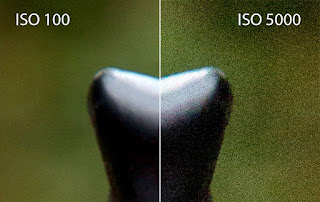Three Elements Of Photography
Learning photography needs some time. It is a vast industry with numerous options to proceed as a career. However, it is difficult to remember so many things to click a better photo. In this scenario, we have the most important or let's say the basis of a photograph which depends on three factors. Those elements are ISO, Aperture and Shutter Speed.ISO
ISO is one of the three pillars or elements of photography and it has a major effect on images taken by a camera. ISO is simply used to brighten or darken your images, it helps a photographer to shoot in low light or during the night. An ISO is shown as numbers like 100, 200, 400, 800, and goes to 6400 which is the highest ISO. However, raising your ISO setting in the camera has some consequences. Due to high ISO, there will be a lot of grains or noise in the image which is not good and ruins the image. The image below will help you understand how ISO works.The above image shows how high ISO will affect the picture. A less ISO means that it has fewer grains but as you increase the ISO limit the grains or what we call noise in the picture increases. The consequence is a rough image with low quality.
Recommended ISO for different scenes
- Outdoors with bright skies: 100-200 ISO
- Outdoors with overcast, sunrise and sunset: 200-400 ISO
- Ambient lit interior: 400-800 ISO
- Semi-lit interior: 800-1600 ISO
- Nightime exterior or low lit interior: 1600-6400 ISO
- Indoor or nighttime sports: 1600-8000 ISO

APERTURE
 An aperture plays an important role in setting up for the best shot. It can be defined as an opening in the lens through which light passes to enter the camera sensor. It can be easily understood if we think about how our eyes work. As we move between brighter and dark environments our pupil or the iris in the eyes either shrinks or expands. This is how the aperture works in a camera. You can adjust either shrink or enlarge the size of the aperture in a lens to allow more or less light to enter the camera sensor.
An aperture plays an important role in setting up for the best shot. It can be defined as an opening in the lens through which light passes to enter the camera sensor. It can be easily understood if we think about how our eyes work. As we move between brighter and dark environments our pupil or the iris in the eyes either shrinks or expands. This is how the aperture works in a camera. You can adjust either shrink or enlarge the size of the aperture in a lens to allow more or less light to enter the camera sensor.Aperture adds dimension to your photo by controlling depth of field. The image below will help you understand how aperture works.
Aperture is shown or expressed as a number known as “f-number” or “f-stop”, with the letter “f” appearing before the number, like f/8, f11. Aperture helps you adjust the depth of field while taking portrait photos keeping one object in focus and the blurry background like in the image below. As a Depth Of Field, using the small aperture value like f/2.8 will result in a large amount of background blur suited for portrait photography whereas aperture value like f/8 or more helps to keep in focus the foreground and background best suited for landscape or architect photography.
SHUTTER SPEED
 The characteristic sound made by a camera when we click that shutter release button to click a photograph is called the shutter of a camera. A shutter is actually a barrier that keeps light out of the camera sensor when we are not taking a photo and opens when we click on the shutter button. But it is always not at the same speed. Shutter speed varies from the type or location of the photo you want to take. For example, if you want to capture a fast-moving object then we need to increase the speed of a shutter so that the camera detects the speed of the object and clicks to take a photo. A shutter speed tells us for how long a camera shutter should be open to enable light pass through the lens and reach the camera sensor.
The characteristic sound made by a camera when we click that shutter release button to click a photograph is called the shutter of a camera. A shutter is actually a barrier that keeps light out of the camera sensor when we are not taking a photo and opens when we click on the shutter button. But it is always not at the same speed. Shutter speed varies from the type or location of the photo you want to take. For example, if you want to capture a fast-moving object then we need to increase the speed of a shutter so that the camera detects the speed of the object and clicks to take a photo. A shutter speed tells us for how long a camera shutter should be open to enable light pass through the lens and reach the camera sensor.You will get an idea of how a shutter speed matter in an image below. It is measured in a fraction of a second. For example, 1/4 means a quarter of a second, while 1/250 means one-two-hundred-and-fiftieth of a second.
Simple, isn't it? Yes, practicing these three main elements of photography will help understand how a camera reacts to different surroundings and light. We then know which setting fits best to click brilliant pictures.
Thank you for reading!!




Comments
Post a Comment